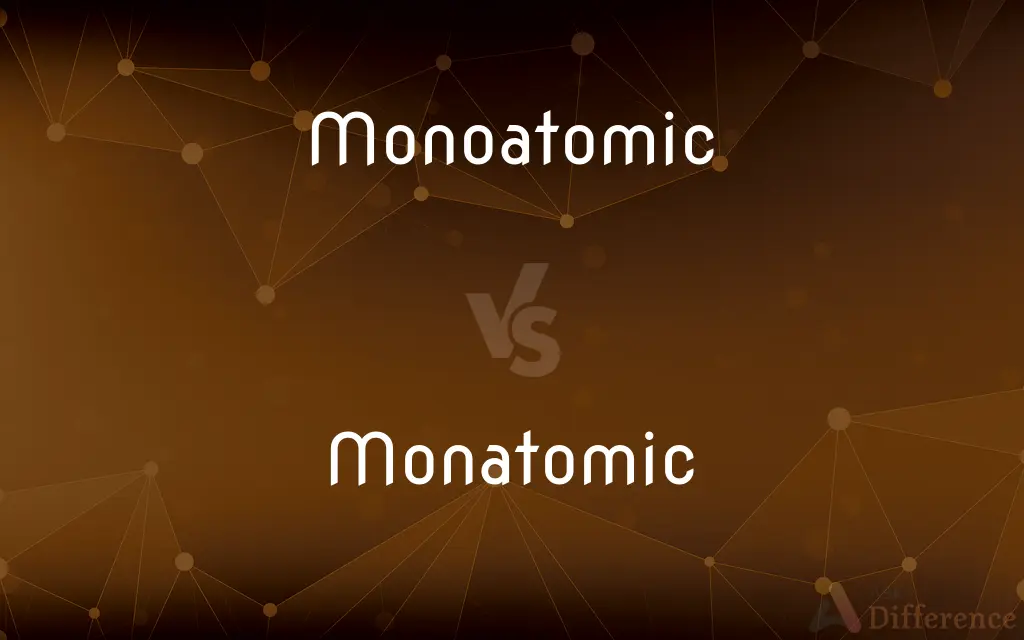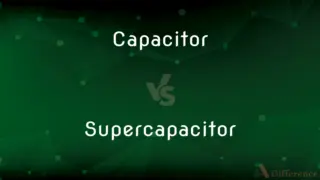Monoatomic vs. Monatomic — What's the Difference?
Edited by Tayyaba Rehman — By Fiza Rafique — Updated on April 4, 2024
Monoatomic refers to ions or molecules consisting of a single atom, pivotal in chemistry for their stability and reactivity. Monatomic, while technically identical, is less commonly used in scientific texts.

Difference Between Monoatomic and Monatomic
Table of Contents
ADVERTISEMENT
Key Differences
Monoatomic elements are found in the noble gases group of the periodic table, demonstrating complete electron shells that contribute to their chemical inertness. On the other hand, monatomic, despite being an alternate term, is less frequently encountered in academic and scientific discussions, leading to a preference for "monoatomic" in formal texts.
Monoatomic ions, play critical roles in various chemical reactions due to their single-atom structure, which allows for straightforward ionic bonding. Monatomic ions, similarly essential, are described with the same term but encounter less usage in literature, highlighting a linguistic preference rather than a conceptual difference.
In high-temperature environments, certain elements can exist in a monoatomic state, where individual atoms are not bound to others, emphasizing the term's importance in describing states of matter under specific conditions. Monatomic's usage mirrors this context, underscoring its interchangeable nature with "monoatomic" in scientific accuracy but not in commonality.
The study of monoatomic gases, such as helium or neon, provides insights into fundamental physical and chemical properties since their simplicity aids in theoretical and computational modeling. The term monatomic, while accurately describing the same gases, is seen less in educational and research materials, reflecting a subtle distinction in nomenclature preference.
Monoatomic particles' interaction with electromagnetic fields is a key area of research in physics, highlighting their significance beyond basic chemistry. Monatomic, when used in such discussions, serves the same purpose and meaning, reinforcing the idea that the choice between the two terms is largely stylistic and traditional.
ADVERTISEMENT
Comparison Chart
Definition
Refers to ions or molecules composed of a single atom.
Identical in meaning but less preferred in scientific writing.
Usage Frequency
More commonly used in scientific and academic texts.
Less commonly used, with identical meaning.
Context of Use
Predominantly in discussions about noble gases and ions.
Same contexts, but with less frequency.
Linguistic Preference
Favored in formal scientific literature.
Less favored, reflecting a stylistic choice.
Impact on Scientific Discussions
Central to understanding chemical reactions and states of matter.
Equally important but less cited in literature.
Compare with Definitions
Monoatomic
Monoatomic ions consist of a single atom with a positive or negative charge.
Sodium forms a monoatomic ion in solution.
Monatomic
Monatomic gases are rare in nature, existing primarily among the noble gases.
Neon is a monatomic gas used in neon signs.
Monoatomic
In plasma physics, monoatomic species are studied for their unique properties.
In high-energy physics, monoatomic helium is frequently analyzed.
Monatomic
In theoretical models, monatomic particles help simplify calculations.
Monatomic gases are used in simulations of gas dynamics.
Monoatomic
Monoatomic gases, like helium, do not form molecules under standard conditions.
Helium is a monoatomic gas widely used in balloons.
Monatomic
High temperatures can cause some elements to become monatomic.
Iron can exist in a monatomic state in a plasma torch.
Monoatomic
Noble gases are naturally occurring monoatomic elements.
Argon is a monoatomic element used in lighting.
Monatomic
Monatomic elements are essential for understanding quantum physics.
Monatomic helium is studied for superfluidity.
Monoatomic
Monoatomic gold is often discussed in the context of alternative medicine.
Monoatomic gold is claimed to have health benefits, though scientifically unproven.
Monatomic
Monatomic ions play a fundamental role in electrochemistry.
The chloride ion is a common monatomic ion.
Monoatomic
Alternative form of monatomic
Monatomic
Occurring as single atoms
Helium is a monatomic gas.
Monoatomic
Of or relating to an element consisting of a single atom;
Helium and argon are monatomic gases
Monatomic
(chemistry) Of an element, consisting of a single atom in the molecule, for example, the noble gases. Note: Strictly speaking, a molecule has at least two atoms.
Monatomic
Consisting of, or containing, one atom; as, the molecule of mercury is monatomic.
Monatomic
Of or relating to an element consisting of a single atom;
Helium and argon are monatomic gases
Common Curiosities
Why is monoatomic important in chemistry?
Monoatomic species, such as noble gases and ions, are fundamental in studying chemical reactions and bond formations.
Is there a difference between monoatomic and monatomic?
No, the terms are technically interchangeable, though "monoatomic" is more commonly used in scientific literature.
What does monoatomic mean?
Monoatomic refers to species consisting of a single atom, important in understanding chemical and physical properties.
Why is "monatomic" less used than "monoatomic"?
The preference for "monoatomic" likely stems from traditional and stylistic choices within scientific communities.
What role do monoatomic ions play in the human body?
Monoatomic ions are crucial in biological processes, including nerve impulse transmission and cellular metabolism.
How are monoatomic ions formed?
Monoatomic ions form through the loss or gain of electrons, resulting in charged particles with a single atom.
Can elements be naturally monoatomic?
Yes, noble gases are natural examples of monoatomic elements due to their stable electronic configurations.
What are monoatomic ions?
Monoatomic ions are charged particles consisting of a single atom, playing key roles in electrical conductivity and chemical reactions.
Do monoatomic gases have any practical uses?
Yes, monoatomic gases like helium are used in balloons, and neon in lighting due to their unique properties.
Can monoatomic elements form compounds?
While monoatomic elements like noble gases are generally inert, under certain conditions, they can form compounds, albeit rarely.
How do monoatomic elements exist under standard conditions?
Most monoatomic elements, like noble gases, exist as gases at room temperature due to their complete electron shells.
Are all noble gases monoatomic?
Yes, all noble gases are monoatomic, characterized by their inertness and stability under standard conditions.
Can metals be monoatomic?
Metals can exist in a monoatomic form under extreme conditions, such as in a plasma state.
What is the significance of monoatomic species in physics?
Monoatomic species are vital in studies of quantum mechanics, superconductivity, and electromagnetic interactions.
What research areas focus on monoatomic species?
Research in chemistry, physics, and materials science focuses on monoatomic species to explore fundamental principles and applications.
Share Your Discovery

Previous Comparison
Capacitor vs. Supercapacitor
Next Comparison
Harbour vs. DockAuthor Spotlight
Written by
Fiza RafiqueFiza Rafique is a skilled content writer at AskDifference.com, where she meticulously refines and enhances written pieces. Drawing from her vast editorial expertise, Fiza ensures clarity, accuracy, and precision in every article. Passionate about language, she continually seeks to elevate the quality of content for readers worldwide.
Edited by
Tayyaba RehmanTayyaba Rehman is a distinguished writer, currently serving as a primary contributor to askdifference.com. As a researcher in semantics and etymology, Tayyaba's passion for the complexity of languages and their distinctions has found a perfect home on the platform. Tayyaba delves into the intricacies of language, distinguishing between commonly confused words and phrases, thereby providing clarity for readers worldwide.















































